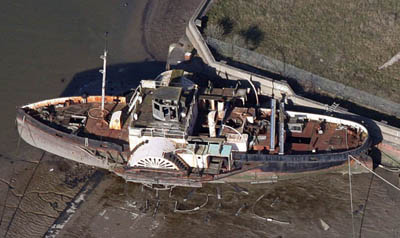|
Click
thumbnails for a larger image
|
|
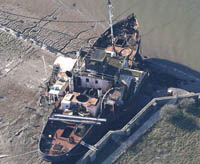 |
The
vessel could not be towed away because her hull was corroded
and could not be trusted to survive a hazardous tow.
It
would have been embarrassing for the developers to have her
cut up because she is one of the most important historic vessels
in the country.
The
only option was to lift her with a giant crane and place her
on her own pontoon.
|
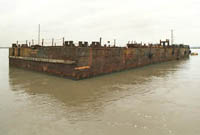 |
To
the casual observer the John H Amos was known as "that paddle
tug abandoned and sunk at Chatham". Behind the scenes it
was very different:
A
massive pontoon, the Portal Narvik, was acquired.
|
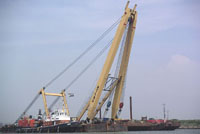 |
A
suitably large floating crane, Atlas, one of the largest in
Europe, operated by Chatham based GPS Marine, was contracted
at a non-commercial price.
|
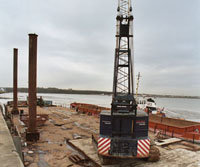 |
The
Portal Narvik was put to work to help pay for the Atlas. GPS
Marine used the pontoon with a crane on board to help build
a jetty at the Isle of Grain.
The
proceeds from this co-operation were put towards the cost of
the lift.
|
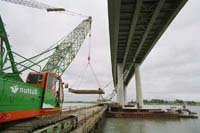 |
Timber
was found to re-enforce the deck of the pontoon.
Nuttalls
plc donated some timber forming a temporary pier used during
the construction of the Sheppey crossing, a new bridge over
the Swale.
This
was collected by a tug and barge courtesy of GPS Marine.
|
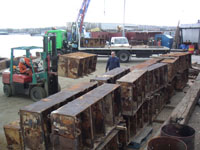 |
Dock
blocks were borrowed.
Chatham
Historic Dockyard Trust donated some redundant dock blocks for
the John H Amos to sit on.
A
suitable mooring was arranged for the pontoon.
|
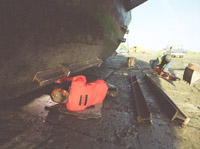 |
Railway
lines were borrowed and welded to re-inforce the hull of the John
H Amos.
|
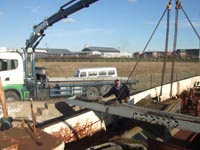 |
Steel
girders were located and transported to re-enforce the deck of
the John H Amos. |
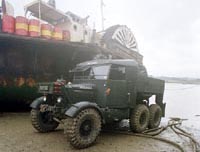 |
The
eleven-and-a-half inch steel strops were pulled into position
by Derek Gransden's Scammell recovery truck. |
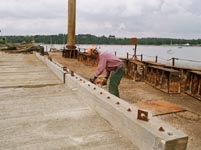 |
Martin
Stevens cut the pier timbers to support the dock blocks. |
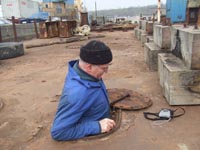 |
Ted
Spears, marine surveyor, inspected the Portal Narvik. |
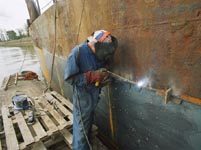 |
Steve Leigh welded 21 metres of new steel plate to the hull of
the Portal Narvik. |
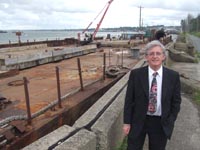 |
Martyn
Heighton came to inspect the work, which was paid for with the
help of a grant from National Historic Ships.
The
date of the possible lift changed ten times between mid February
and mid March. A difficult scenario to give notice to others
involved.
|
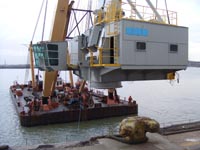 |
Since
the middle of February it was beginning to look as though the
crane barge Atlas would have two commercial jobs to do in the
South East of England. These had to be in place before a subsidised
lift of the John H Amos could be done. |
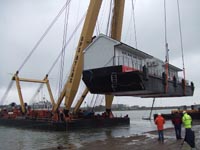 |
The
jobs materialised.
One
to lift a crane onto a quay in the Thames and the other to launch
a pontoon, destined for Cherry Gardens Pier in London, built
within a few miles of Chatham.
|
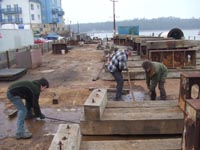 |
Martin
Stevens was determined that everything should be ready just
in case the big lift happened this time.
After
two years of postponement it had never felt so close.
With
a small group of volunteers lead by Martin Staniforth, the final
preparations were put in place. In the absence of a crane the
dock blocks were moved by leverage.
|
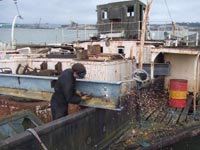 |
Blocks
of greenheart wood were fastened to the end of the girders to
protect the lifting strops. |
| |
The
Three Lifts
There
were to be three separate days to the operation.
Lift
one to position extra strops.
The Big Lift to position the tug on the transport barge.
Lift three to transfer the tug onto the Portal Narvik.
|
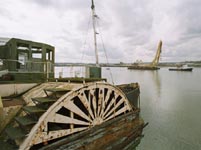 |
Wednesday
26th March 2008
Martin
Staniforth was still welding extra steel re-enforcements to
the spreader beams, when on the lunchtime high tide the Atlas
appeared for the first of the three lifts.
|
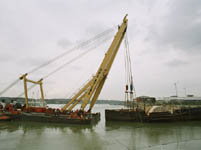 |
The
first part of the lift was to raise the bow of the John H Amos
and slide two wire lifting strops under the hull.
The
two others had been placed in position almost two years previously.
This was to be a critical test of the hull structure. Any vessel
with less structural strength would have broken her back.
|
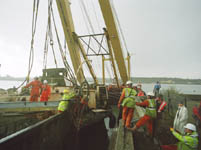 |
This
having been competently completed, the Atlas retreated until high
tide the next day.
Thursday
27th March 2008
The
hooks of the Atlas were attached to the four lifting strops.
|
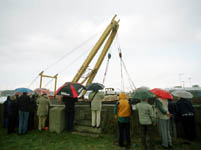 |
Onlookers
braved the English weather as the John H Amos was raised from
what some locals called her "watery grave". |
 |
A
marine surveyor who had been helping with the preparations admitted
to having tears in his eyes.
The
John H Amos was turned 90 degrees.
|
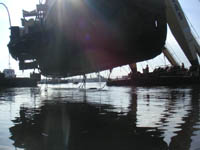 |
Holes
had been cut in the hull of the John H Amos to allow the water
to drain rapidly as she was lifted. The crane operator said that
the weight on the crane was 330 tonnes when the lift started and
225 tonnes after the water had drained. |
 |
Martin
Stevens photographed and videoed everything.
|
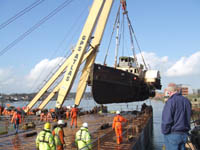 |
When
the John H Amos had been lifted and turned parallel to the river,
a transport barge was floated under her and she was lowered
onto the deck.
About
80% of the weight was still supported by the crane.
|
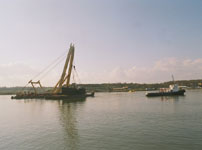 |
In the meantime the Medway Maritime Trust pontoon, Portal Narvik,
had been moved down river to a deeper mud berth for the transfer.
This was to happen at high tide the next day.
|
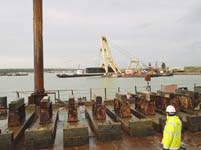 |
Friday
28th March 2008
The
director of operations, Dutchman Jaco Sluijmers, had decided
to bring the pontoon Portal Narvik across the river to the John
H Amos because there would be more time for the transfer without
the restriction of a falling tide.
|
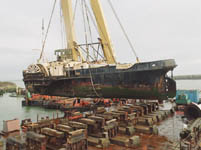 |
This
was a well judged decision as it proved to be a difficult job
to free the strops. |
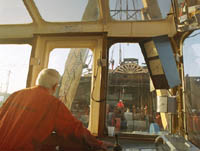 |
John
H Amos was lifted off the transport barge, which was then removed. |
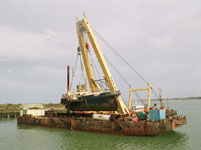 |
Portal
Narvik was manoeuvred into position. |
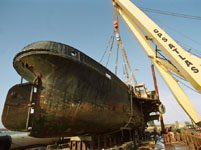 |
The
John H Amos was lowered onto her new home. |
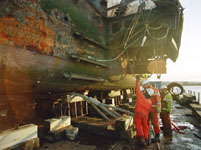 |
The
lifting strops were extracted from beneath the John H Amos. |
 |
John
H Amos did not sit quite straight, but was now supported on dock
blocks. |
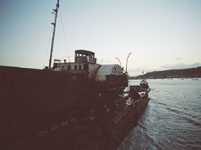 |
So
began a tow up river in the dark, past her old home in the dockyard
where the John H Amos had spent the last decade, to a buoy in
Rochester.
|
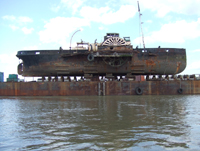 |
For
exactly a year, one of the best views of the John H Amos was from
Rochester railway station, where commuters to London regularly
telephoned Martin Stevens to tell him "she's still there!" |
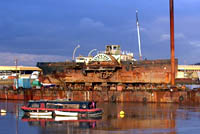 |
The
disadvantage of mooring in the middle of the river was that almost
no work could be done. |
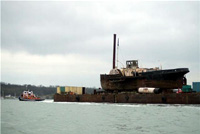 |
On
13th March 2009 the John H Amos and Portal Narvik were towed in
turn by the GPS tugs Friston Down and Haulier to a tidal berth
on the River Medway in Chatham Docks. |
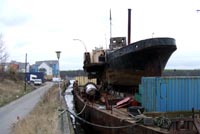 |
This
means initial work can now begin. The first jobs will be to
clean the vessel and begin a comprehensive recording programme.
This
is necessary because, despite having a complete set of original
drawings for the ship, the details added by "old Fred in
the shipyard" will ensure that the restored vessel will
have all the authenticity of the 1931 vessel.
|
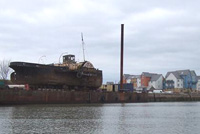 |
Now
the best view of John H Amos can be enjoyed by the residents of
the new apartments in Chatham Maritime! |
| |
The
John H Amos needs a great deal of urgent preservation work this
summer. If anyone is interested they can come and see us at
the TID 164 steam tug in Chatham Historic Dockyard on Saturdays,
or we have set up a dedicated mobile telephone number for recruitment
which people can call or send a text.
Please
call 07908 059215 for more information.
|

